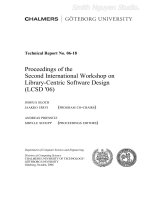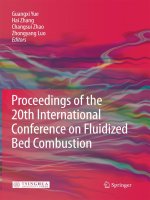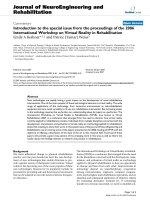Microreaction technology industrial prospects IMRET 3 proceedings of the third international conference on microreaction technology
Bạn đang xem bản rút gọn của tài liệu. Xem và tải ngay bản đầy đủ của tài liệu tại đây (39.95 MB, 709 trang )
Microreaction Technology: Industrial Prospects
Springer
Berlin
Heidelb erg
New York
Barcel ona
Hong Kong
London
Milan
Paris
Singap ore
Tokyo
W. Ehrfeld (Ed.)
Microreaction Technology:
Industrial Prospects
IMRET3:
Proceedings of the Third International Conference
on Microreaction Technology
With 481 Figures
Springer
Professor Dr. Wolfgang Ehrfeld
Institut flir Mikrotechnik Mainz GmbH
Carl-Zeiss-StraBe 18-20
55129 Mainz
Germany
ISBN-13: 978-3-642-64104-6
CIP data applied for
Die Deutsche Bibliothek - CIP-Einheitsaufnahme
Microreaction technology: industrial prospects; proceedings ofthe Third International
Conference on Microreaction Technoloy 1IMRET 3. W. Ehrfeld (ed.). - Berlin; Heidelberg;
New York; Barcelona; Hong Kong; London; Milan; Paris; Singapore; Tokyo:
Springer, 2000
ISBN-13:978-3-642-64104-6
e-ISBN-13:978-3-642-59738-1
DOl: 10.1007/978-3-642-59738-1
This work is subject to copyright. All rights are reserved, whether the whole or part of the material is
concerned, specifically the rights of translation, reprinting, reuse of illustrations, recitation,
broadcasting, reproduction on microfilms orin any other ways, and storage in data banks. Duplication
of this publication or parts thereof is only permitted under the provisions of the German Law of September 9, 1965, in its current version, and permission for use must always be obtained from SpringerVerlag. Violations are liable for prosecution under the German Copyright Law.
Springer-Verlag is a company in the BertelsmannSpringer publishing group
© Springer-Verlag Berlin Heidelberg 2000
Softcover reprint of the hardcover 1st edition 2000
The use of general descriptive names, registered names, trademarks, etc. in this publication does not
imply, even in the absence of a specific statement, that such names are exempt from the relevant
protective laws and regulations and therefore free for general use.
Typesetting: Camera ready by authors
Cover: Medio, Berlin;
Printed on acid-free paper SPIN: 10751815
62/3020 hu - 5 4 3 2 I 0
Preface
Since the First International Conference on Microreaction Technology, held in
Frankfurt I M., Germany in spring 1997, an extremely rapid development in
fabrication and use of microreactors for a large variety of processes took place.
Within only a few years time, the concepts of microreaction technology have
found worldwide attention both in industry and basic R&D. Various applications
in process engineering, screening purposes and basic research have been
identified and investigated thoroughly. In many cases, microreaction systems
already have left the state of lab-scale R&D, finding their way to industrial
processing and commercialization.
Consequently, main focus of this years IMRET 3, again held in Frankfurt I M.
on April 18 - 21, 1999, turned out to be on industrial prospects of this new technology and its neighboring fields. This symposium, like its 1998 predecessor, held
in New Orleans, LA, was organized by Battelle Memorial Institute, the American
Institute of Chemical Engineers (AIChE), the Society for Chemical Engineering
and Biotechnology (DECHEMA) and the Institute of Microtechnology Mainz
(lMM). The conference, featuring 84 contributions, was a successful forum for
discussion of recent developments in design and fabrication of microreactors as
well as applications in chemical production, combinatorial chemistry, catalysis,
biotechnology and power generation.
The lectures and discussions once more showed a broad range of opinions
regarding microreaction technology. These ranged from general scepticism
concerning applicability of microreactors to recommendation of their use as tool
for process optimization and convincing statements with respect to their
utilization in industry. However, the first examples for successful industrial
exploitation of microreaction systems seem to have a positive effect on the
dissemination of microreactor concepts. These pioneering activities indicate the
beginning of a new era in chemistry and reaction engineering characterized by
increasing flexibility in production and R&D.
The book at hand comprises the full papers of the contributions to IMRET 3,
giving a comprehensive overview on the present state-of-the-art in microreaction
technology. We thank all contributors to this conference and hope, this book will
prove to be a valuable and useful guide to scientists and researchers in this
exciting new field in reaction engineering, chemistry and biotechnology.
September 1999
G. Kreysa (DECHEMA)
W. Ehrfeld (IMM)
Table of Contents
Author Index .................................................. .
Part 1
Opening Lectures
Process Intensification Through Miniaturization of Chemical and Thermal
Systems in the 21st Century. . . . . . . . . . . . . . . . . . . . . . . . . . . . . . . . . . . . . ..
2
R.S. Wegeng, M.K. Drost, D.L. Brenchley
Implementation of Microreaction Technology in Process Engineering
W Ehrfeld, V. Hessel, S. Kiesewalter, H. LOwe, Th. Richter, J. Schiewe
14
Part 2
Design and Production of Microreactor Systems
Lecture Session
Fabrication and Application of Silicon-based Microchannels .... . . . . . . . .. 36
J.G.E. Gardeniers, R. W Tjerkstra, A. van den Berg
Macroporous and Mesoporous Silicon: New Materials for Microfluidic and
Microreaction Devices ................ . . . . . . . . . . . . . . . . . . . . . . . . . .. 45
V. Lehmann
The Effect of Shape Variation in Microlamination on the Performance of
High-Aspect-Ratio, Metal Microchannel Arrays ....................... 53
B.K. Paul, R.B. Peterson, W Wattanutchariya
Fabrication of Microchannel Chemical Reactors Using a Metal Lamination
Process ........................................................ 62
D. W Matson, P.M. Martin, D. C. Stewart. A.L. Y. Tonkovich, M. White,
J.L. Zilka, G.L. Roberts
Poster Session
Microreactor Technology for Biological Applications. . . . . . . . . . . . . . . . . .. 72
G.M. Greenway, T. McCreedy
VIII
Laserprocessing for Manufacturing Microfluidic Devices. . . . . . . . . . . . . . ..
80
E. Bremus, A. Giltner, D. Hellrung, H. Hocker, F. Legewie, R. Poprawe,
M. Wehner, M. Wild
Functional Coatings for Microstructure Reactors and Heat Exchangers ..... 90
M. Fichtner, W. Benzinger, K. Haas-Santo, R. Wunsch, K. Schubert
Polymer Nanowell Plates with Variable Well Slope Angles .............. 102
H. Becker, T. Klotzbucher
Micro Molding of Fluidic Devices for Biochemical Applications .......... 113
M. Niggemann, W. Ehrfeld, L. Weber
Part 3
Microreactors in Combinatorial Chemistry
Lecture Session
Combinatorial Organic Compound Libraries on Continuous Surfaces:
Towards Chemical Chips ......................................... 124
L. Germeroth, U. Reineke, K. Dietmeier, C. Piossek, N. Heine, D. Scharn,
T. Ast, M. Schulz, H. Matuschewski, A. Kramer, J. Schneider-Mergener,
H. Wenschuh
Part 4
Microreactors in Production Processes
Lecture Session
Electrochemical Microreactors: A New Approach for Microreaction
Technology .................................................... 136
A. Ziogas, H. Lowe, M. Kupper, W. Ehrfeld
High Temperature HCN Generation in an Integrated Microreaction System .. 151
V. Hessel, W. Ehrfeld, K Golbig, C. Hofmann, St. Jungwirth, H. Lowe,
Th. Richter, M. Storz, A. Wolf, O. Worz, 1. Breysse
Micro Mixing Effects in Continuous Radical Polymerization ............. 165
T. Bayer, D. Pysalt, O. Wachsen
Novel Liquid Phase Microreactors for Safe Production of Hazardous
Specialty Chemicals . . . . . . . . . . . . . . . . . . . . . . . . . . . . . . . . . . . . . . . . . . . . . 171
T.M. Floyd, M. W. Losey, S.L. Firebaugh, KF. Jensen, M.A. Schmidt
IX
Experiences with the Use of Microreactors in Organic Synthesis .......... 181
H. Krummradt, V. Koop, 1. Stoldt
A Microstructured Reactor for the Catalytic Partial Oxidation of Methane to
Syngas ........................................................ 187
J. Mayer, M Fichtner, D. Wolf, K. Schubert
Expansion of Microreactor Capabilities through Improved Thermal
Management and Catalyst Deposition ................................ 197
A.J. Franz, S.K. Ajmera, S.L. Firebaugh, K.F. Jensen, MA. Schmidt
Synthesis of Ethylene Oxide in a Microreaction System ................. 207
H. Kestenbaum, A. Lange de Oliveira, W. Schmidt, F. Schuth, W. Ehifeld,
K. Gebauer, H. Lowe, Th. Richter
Selective Reactions in Microchannel Reactors ......................... 213
A. Kursawe, E. Dietzsch, S. Kah, D. Honicke, M Fichtner, K. Schubert,
G. WieJ3meier
Periodic Operation in Microchannel Reactors ......................... 224
MA. Liauw, M Baerns, R. Broucek, O. V. Buyevskaya, 1.-M Commenge,
1.-P. Corriou, L. Falk, K. Gebauer, H.1. Hefter, D.-V. Langer, H. Lowe,
M Matlosz, A. Renken, A. Rouge, R. Schenk, N. Steinfeldt, St. Walter
Poster Session
Micro-Reactor Synthesis: Synthesis of Cyanobiphenyls Using a Modified
Suzuki Coupling of an Aryl Halide and Aryl Boronic Acid ............... 235
V. Skelton, G.M Greenway, SJ. Haswell, P. Sty ring, D.O. Morgan
Optimization of Reaction-Separation Networks via Mass Integration on the
/l-Scale ........................................................ 243
F. Stepanek, M. Marek
Modelling of Gas-Liquid Catalytic Reactions in Microchannels ........... 253
P. Angeli, D. Gobby, A. Gavriilidis
Simultaneous Screening of Catalysts in Microchannels: Methodology and
Experimental Setup .............................................. 260
T. Zech, D. Honicke, A. Lohf, K. Golhig, Th. Richter
Palladium Membrane Microreactors ................................. 267
A.J. Franz, K.F. Jensen, MA. Schmidt
A Micro Packed-Bed Reactor for Chemical Synthesis ................... 277
M W. Losey, M.A. Schmidt, K.F. Jensen
x
Parallel Synthesis and Testing of Heterogeneous Catalysts ............... 287
U. Rodemerck, P. Ignaszewski, M. Lucas, P. Claus, M. Baerns
Single Flow Electrochemical Microreactor Application to Furan
Methoxylation .................................................. 294
R. Ferrigno, V. Reid, HH Girault
PartS
Microfluidics
Lecture Session
Microfluidic Devices for Sample Preparation (Liquid) in the Nanoliter
Range ......................................................... 302
H Fiehn
Liquid Handling in the Pico- and Nanoliter Range ...................... 312
W. Meyer, M. Doring
Flow-Through Microdispenser for Liquid Handling in a Levitated-Droplet
Based Analyzing System .......................................... 320
J. Nilsson, T. Laurell, M. Petersson, S. Santesson, T. Johansson,
E. Degerman, S. Nilsson
Simulation of Microscale Chemical Separation Processes Using the LatticeBoltzmann Method .............................................. 327
D.R. Rector, B.J. Palmer
Modelling of Complex Reaction-Separation Processes in a D.C. Electric
Field in Microchannels ........................................... 336
D. Snita, J. Kosek, H Sevcikova, J. Lindner, J. Havlica, M. Paces,
M. Marek
Poster Session
Microporous Silica Structures for the Immobilisation of Catalysts and
Enhancement of Electroosmotic Flow (EOF) in Micro-Reactors ........... 346
N.G. Wilson, T. McCreedy
A New Hydraulic Stroke Amplifier for Microfluidic Components ......... 353
N. Schwesinger, S. Pobering
XI
Part 6
Microreactors for Energy Generation and Storage
Lecture Session
Microchannel Chemical Reactors for Fuel Processing Applications.
II. Compact Fuel Vaporization ..................................... 364
AL Y. Tonkovich, S.P. Fitzgerald, JL Zilka, M.J. LaMont, Y. Wang,
D.P. VanderWiel, R.S. Wegeng
Microstructured Catalysts for Methanol-Steam Reforming ............... 372
P. Pfeifer, M. Fichtner, K. Schubert, M.A. Liauw, G. Emig
Fuel Cells for Low Power Applications .............................. 383
C. Hebling, A. Heinzel, D. Golombowski, T. Meyer, M. Muller, M. Zedda
Poster Session
Recent Developments in Microtechnology-Based Chemical Heat Pumps .... 394
M.K. Drost, M. Friedrich, C. Martin, J. Martin, R.J. Cameron
Miniaturised Direct Methanol Fuel Cell with a Plasma Polymerised
Electrolyte Membrane ............................................ 402
L. Mex, J. Muller
Part 7
Application of Microreactors in Drug Development and
Biotechnology
Lecture Session
Rapid PCR in Flow-Through Si Chip Thermocyc\ers ................... 410
S. Poser, R. Ehricht, T. Schulz, S. Uebel, U. Dillner, J. M. Kohler
Disposable Electrophoresis Chip for High Throughput Analysis of
Biomolecules .................................................... 420
R. Konrad, W. Ehrfeld, H.-J. Hartmann, P. Jacob, M. Neumann,
R. Pommersheim, I. Sommer, J. Wolfrum
A Micromachined Analysis System for Rapid Protein Identification ........ 430
S. Ekstrom, P. Onneifjord, M. Bengtsson, J. Nilsson, T. Laurel!,
G. Marko-Varga
XII
Simulation of Biochemical Reaction Kinetics in Microfluidic Systems ...... 441
V.B. Makhijani, 1. Raghavan, A. Przekwas, A.1. Przekwas
Microfluidic Devices on Polymer Substrates for Bioanalytical Applications .. 451
1'. Lin, D. W Matson, D.E. Kurath, 1. Wen, F. Xiang, WD. Bennett,
P.M. Martin, R.D. Smith
Poster Session
Transfer of Plasmid DNA into Cells with Microelectroporation Arrays on a
Chip .......................................................... 461
R.Poppe
On-line Monitoring of Enzyme Activities Using Microreactor Heat Power
Meters ........................................................ 469
1. Lerchner, A. Wolf, A. Weber, R. Hiittl, G. Wolf, 1.M. Kohler, M. Zieren
Isothermal Biochemical Amplification in Miniaturized Reactors with
Integrated Microvalves ........................................... 479
R. Brautigam, D. Steen, R. Ehricht, 1.S. McCaskill
Microfluidic Filtration Chip for DNA Extraction and Concentration ........ 488
A. Przekwas, D. Wang, V.B. Makhijani, A.1. Przekwas
PartS
Commercialization of Microreaction Technology
Lecture Session
The Commercial Use of Multilayer Microcapsules for Biotechnological
Applications .. . . . . . . . . . . . . . . . . . . . . . . . . . . . . . . . . . . . . . . . . . . . . . . . . . 500
R. Pommersheim, A. Noack, S. Scholz
Part 9
Microreaction Devices
Lecture Session
A Capillary Force Filled Auto-Mixing Device ......................... 506
R. U. Seidel, D.1'. Sim, W. Menz, M. Esashi
Fast Heating and Cooling for High Temperature Chemical Microreactors ... 514
Ch. Alepee, R. Maurer, L. Paratte, L. Vulpescu, Ph. Renaud, A. Renken
XIII
Gas / Liquid Microreactors for Direct Fluorination of Aromatic Compounds
Using Elemental Fluorine ......................................... 526
V. Hessel, W Ehifeld, K. Golbig, V. Haverkamp, H. Lowe, M. Storz,
Ch. Wille, A.E. Guber, K. liihnisch, M. Baerns
Solvent Extraction and Gas Absorption Using Microchannel Contactors .... 541
WE. TeGrotenhuis, R.J. Cameron, V. V. Viswanathan, R.S. Wegeng
Poster Session
Polymer Membranes for Product Enrichment in Microreaction Technology .. 550
B. Schiewe, A. Vuin, N. Gunther, K. Gebauer, Th. Richter, G. Wegner
Compact Heat Exchangers ........................................ 556
L.A. Luo, U. D'Ortona, D. Tondeur
Optimizing the Geometry of a Catalytic Enzyme Microreactor in Porous
Silicon ........................................................ 566
M. Bengtsson, 1. Drott, T. Laurell
High Aspect Ratio Silicon Micromachined Heat Exchanger .............. 573
1. Bengtsson, L. Wallman, T. Laurel!
Comparison of Two Microvalve Designs Fabricated in Mild Steel ......... 578
B.K. Paul, T. Terhaar
Integrated Microfluidics / Electrochemical Sensor System for FieldMonitoring of Toxic Metals ....................................... 588
Y. Lin, D. W Matson, WD. Bennett, K.D. Thrall, C. Timchalk
Thermoelectrical Measurement System for Chemical Instrumentation ...... 597
S. Beij3ner, T. Elbel, 1.M. Kohler, M. Zieren
Electrically Heated Microstructure Heat Exchangers and Reactors ......... 607
1. Brandner, M. Fichtner, K. Schubert
Analytical Module for In-line IR Spectroscopy of Chemical Reactions in
Microchannels .................................................. 617
A.E. Guber, W Bacher
A Microstructure Reactor for Gas Purification ......................... 625
R. Wunsch, M. Fichtner, K. Schubert
A Flexible Multi-Component Microreaction System for Liquid Phase
Reactions ...................................................... 636
Th. Richter, W Ehifeld, V. Hessel, H. Lowe, M. Storz, A. Wolf
XIV
Fast Response Heating Module for Temperature Programmed GC Analysis
in Microreaction Systems ......................................... 645
1. Schiewe, W. Ehifeld, T. Hang, H. Lowe, Th. Richter, X.L. Yan,
A.A. Kurganov, KK Unger
A Silicon-based Microreaction System for Analytical Applications ........ 654
P. Woias, K Hauser, E. Yacoub-George, B. Hillerich
Designing and Constructing Microplants ............................. 664
H. Fink, M.J. Hampe
A Modular Microreactor Design for High-Temperature Catalytic Oxidation
Reactions ...................................................... 674
G. Veser, G. Friedrich, M. Freygang, R. Zengerle
Microstructured Reactor for Consecutive Heterogeneous / Homogeneous Gas
PhaseReactions ................................................. 687
Th. Richter, W. Ehifeld, D. Erntner, K Gebauer, K Golbig, H. Lowe,
A. Lange de Oliveira, W. Schmidt, F. Schuth
x.v
Author Index
Ajmera, S.K ............................... 197
Alepee, Ch ................................. 514
Angeli, P .................................... 253
Ast, T ......................................... 124
Bacher, W .................................. 617
Baerns, M .................... 224, 287, 526
Bayer, T ..................................... 165
Becker, H ................................... 102
BeiSner, S .................................. 597
Bengtsson, J ............................... 573
Bengtsson, M ..................... 430, 566
Bennett, W.D ..................... 451,588
Benzinger, W ............................... 90
Brandner, J. ............................... 607
Brautigam, R. ............................ 479
Bremus, E .................................... 80
Brenchley, D. L. ............................ 2
Breysse, J. .................................. 151
Broucek, R. ................................ 224
Buyevskaya, O.V ....................... 224
Cameron, R.I ..................... 394,541
Claus, P ..................................... 287
Commenge, J.-M ....................... 224
Corriou, J.-P .............................. 224
D'Ortona, U............................... 556
Degerman, E .............................. 320
Dietmeier, K. ............................. 124
Dietzsch, E ................................ 213
DiIlner, U ................................... 410
Doring, M. ................................. 312
Drost, M.K. ............................ 2, 394
Drott, J ....................................... 566
Ehrfeld, W .... 14,113,136,151,207,
.................... .420, 526, 636, 645, 687
Ehricht, R. ......................... 410,479
Ekstrom, S ................................. 430
Elbel, T ...................................... 597
Emig, G ..................................... 372
Erntner, D .................................. 687
Esashi, M ................................... 506
Falk, L ....................................... 224
Ferrigno, R. ............................... 294
Fichtner, M ................. 90, 187,213,
.................................... 372,607,625
Fiehn, H. .................................... 302
Fink, H ....................................... 664
Firebaugh, S.L. .................. 171, 197
Fitzgerald, S.P ........................... 364
Floyd, T.M ................................. 171
Franz, A.I ........................... 197, 267
Freygang, M .............................. 674
Friedrich, G ................................ 674
Friedrich, M .. ,............................ 394
Gardeniers, J.G.E ......................... 36
Gavriilidis, A ............................. 253
Gebauer, K. ........ 207,224,550,687
Germeroth, L. ............................ 124
GiIlner, A ................................... 80
Girault, H.H ............................... 294
Gobby, D ................................... 253
Golbig, K. .......... 151,260,526,687
Golombowski, D ........................ 383
Greenway, G.M ................... 72, 235
Guber, AE ......................... 526,617
Gunther, N................................. 550
Haas-Santo, K. ............................. 90
Hampe, M.I ............................... 664
Hang, T ...................................... 645
Hartmann, H.-J .......................... 420
Haswell, S.I ............................... 235
Hauser, K ................................... 654
Haverkamp, V ............................ 526
Havlica, J ................................... 336
Hebling, C .................................. 383
Hefter, H.J. ................................ 224
Heine, N ..................................... 124
Heinzel, A ................................. 383
Hellrung, D .................................. 80
Hessel, V .............. 14, 151,526,636
Hillerich, B ................................ 654
Hocker, H ..................................... 80
Hofmann, C ............................... 151
Honicke, D ......................... 213, 260
Huttl, R. ..................................... 469
XVI
Ignaszewski, P ........................... 287
Jacob, P..................................... 420
Hihnisch, K. ............................... 526
Jensen, K.F. ........ 171, 197,267,277
Johansson, T .............................. 320
Jungwirth, St. ............................ 151
Kah, S........................................ 213
Kestenbaum, H. .. ....................... 207
Kiesewalter, S.............................. 14
Klotzbucher, T ........................... 102
Kohler, J.M ................. 410, 469, 597
Konrad, R.................................. 420
Koop, U..................................... 181
Kosek, J ..................................... 336
Kramer, A.................................. 124
Krumrnradt, H. .. ........................ 181
Kupper, M................................. 136
Kurath, D.E ............................... 451
Kurganov, A.A. ......................... 645
Kursawe, A................................ 213
LaMont, MJ .............................. 364
Lange de Oliveira, A. ........ 207, 687
Langer, O.-U ............................. 224
Laurell, T ........... .320, 430, 566, 573
Legewie, F................................... 80
Lehmann, V................................. 45
Lerchner, J. .. .............................. 469
Liauw, M.A. ....................... 224, 372
Lin, Y................................ 451,588
Lindner, J................................... 336
Lohf, A...................................... 260
Losey, M.W ....................... 171,277
Lowe, H................ 14, 136, 151,207,
..................... 224, 526, 636, 645, 687
Lucas, M .................................... 287
Luo, L.A .................................... 556
Makhijani, V.B .................. 441,488
Marek, M........................... 243, 336
Marko-Varga, G........................ 430
Martin, C. .. ................................ 394
Martin, J. .. ................................ 394
Martin, P.M ......................... 62, 451
Matlosz, M. .. ............................ 224
Matson, D.W ............... 62, 451, 588
Matuschewski, H. ...................... 124
Maurer, R.................................. 514
Mayer, J..................................... 187
McCaskill, J.S ............................ 479
McCreedy, T ........................ 72,346
Menz, W.................................... 506
Mex, L....................................... 402
Meyer, T .................................... 383
Meyer, W................................... 312
Morgan, D.O .............................. 235
Muller, J ..................................... 402
Muller, M................................... 383
Neumann, M.............................. 420
Niggemann, M........................... 113
Nilsson, J ........................... 320, 430
Nilsson, S................................... 320
Noack, A.................................... 500
Onnerfjord, P............................. 430
Paces, M.................................... 336
Palmer, BJ................................ 327
ParaUe, L. .................................. 514
Paul, B.K .............................. 53, 578
Peterson, R.B. .............................. 53
Petersson, M.............................. 320
Pfeifer, P.................................... 372
Piossek, C.................................. 124
Pobering, S. .. ............................. 353
Pommersheim, R. .............. 420, 500
Poppe, R. .. ................................. 461
Poprawe, R. .. ............................... 80
Poser, S...................................... 410
Przekwas, A. ..................... 441,488
Przekwas, A.J. .. ................. 441, 488
Pysall, D.................................... 165
Raghavan, J............................... .441
Rector, D.R ................................ 327
Reid, V........................................ 294
Reineke, U................................. 124
Renaud, Ph ................................. 514
Renken, A. ......................... 224,514
Richter, Th. (AMTEC) .............. 260
Richter, Th. (IMM) .... 14, 151,207,
............................ 550, 636, 645, 687
Roberts, G.L. ............................... 62
Rodemerck, U............................ 287
Rouge, A.................................... 224
Santesson, S............................... 320
Scharn, D................................... 124
XVII
Schenk, R. .. ............................... 224
Schiewe, B ................................. 550
Schiewe, J. ........................... 14, 645
Schmidt, M.A. .... 171, 197, 267, 277
Schmidt, W ........................ 207,687
Schneider-Mergener, J. .............. 124
Scholz, S .................................... 500
Schubert, K. ................ 90, 187,213,
..................................... 372, 607, 625
Schulz, M .................................. 124
Schulz, T ................................... 410
Schuth, F ............................ 207,687
Schwesinger, N .......................... 353
Seidel, R.U ................................ 506
Sevcikova, H ............................. 336
Sim, D.Y .................................... 506
Skelton, V .................................. 235
Smith, R.D ................................. 451
Snita, D ...................................... 336
Sommer, 1. ................................. 420
Steen, D ..................................... 479
Steinfeldt, N .............................. 224
Stepanek, F. ............................... 243
Stewart, D.C ................................ 62
Stoldt, J. ..................................... 181
Storz, M ...................... 151, 526, 636
Styring, P ................................... 235
TeGrotenhuis, W.E .................... 541
Terhaar, T. ................................. 578
Thrall, K.D ................................ 588
Timchalk, C. .............................. 588
Tjerkstra, R. W ............................ 36
Tondeur, D ................................ 556
Tonkovich, A.L.Y ............... 62, 364
Uebel, S ..................................... 410
Unger, K.K. ............................... 645
Van den Berg, A. ......................... 36
VanderWiel, D.P ....................... 364
Veser, G ..................................... 674
Viswanathan, V.V ..................... 541
Vuin, A ...................................... 550
Vulpescu, L. .............................. 514
Wachsen, O ............................... 165
Wallman, L. ............................... 573
Walter, St. .................................. 224
Wang, D .................................... 488
Wang, Y ..................................... 364
Wattanutchariya, W ..................... 53
Weber, A. ................................. 469
Weber, L. ................................... 113
Wegeng, R.S .................. 2,364,541
Wegner, G .................................. 550
Wehner, M ................................... 80
Wen,J. ....................................... 451
Wenschuh, H. .. .......................... 124
White, M ...................................... 62
WieBmeier, G ............................ 213
Wild,M ....................................... 80
Wille, Ch .................................... 526
Wilson, N.G ............................... 346
Woias, P ..................................... 654
Wolf, Andrej ...................... 151,636
Wolf, Antje ................................ 469
Wolf, D ...................................... 187
Wolf, G ...................................... 469
Wolfrum, J ................................. 420
Worz, O ..................................... 151
Wunsch, R. .......................... 90, 625
Xiang, F..................................... 451
Yacoub-George, E. .................... 654
Yan, X.L. ................................... 645
Zech, T ....................................... 260
Zedda, M ................................... 383
Zengerle R. ................................ 674
Zieren, M ........................... 469, 597
Zilka, J.L. ............................. 62,364
Ziogas, A. .................................. 136
Part 1
Opening Lectures
Process Intensification Through Miniaturization
of Chemical and Thermal Systems in the 2rt
Century
Robert S. Wegeng, M. Kevin Drost, David L. Brenchley
Pacific Northwest National Laboratory, PO Box 999, Richland, WA 99352 USA
Abstract
The 21 st century holds great promise for development of Micro Chemical and
Thermal Systems (MICRO-CATSTM). The quest for miniaturization will lead to
greater process intensification. Miniaturizationgreatiy reduces the resistances to heat
and mass transfer. When heat and mass transfer rates are increased by orders of
magnitude, revolutionary changes occur in technology.
Miniaturization of electronics over the past few decades has transformed the way
we live. The invention of the transistor meant that small, lightweight portable radios
could be carried anywhere. Not long ago the idea of chips was revolutionary; today
chips make hand-held computers, cell phones, and many other hand-held electrical
devices possible. These are examples of distributed technology made possible by
miniaturization.
Miniaturization of chemical and thermal systems will take us on a similar
technological journey. Already demands are driving the development of MICROCATS. The quest for miniature systems is leading to man-portable cooling,
automotive fuel processing, and in situ resource utilization for space exploration.
The 21 5t century will see great progress in the development and use of engineered
nanosystems. In electronics, the concept of "molecular electronics" is seen as a way
to further increase the power. The same will occur in MICRO-CATS. We envision
using engineered nanosystems to create more powerful microscale devices with
highly functional surfaces that incorporate enzymes and chemical catalysts. These
surfaces will make the device or system more efficient and reliable; they will be able
to repair, renew, or replace themselves; eliminate or heal themselves from surface
fouling; and carry out step-by-step chemical reactions. Molecular coatings will
create a molecular assembly line. By incorporating enzymes, reactions that are conventionally carried out at high temperatures and pressures can be achieved at ambient
conditions. Finally, in the 21 5t century, the missions for outer space will create
opportunities for MI CRO-CA TS to be major parts of the successful exploration of
space. The future for MICRO-CATS is as wide open as outer space itself!
Keywords: miniaturization, microscale systems, reactors, heat pumps
W. Ehrfeld (ed.), Microreaction Technology: Industrial Prospects
© Springer-Verlag Berlin Heidelberg 2000
3
1 Process Intensification
Micro Chemical and Thermal Systems (MICRO-CATS) use miniaturization to
achieve process intensification. Process intensification is a measure of the amount
of productivity that can be accomplished per unit volume. This increase in process
intensification occurs because miniaturization significantly reduces the resistances
to heat and mass transfer. Imagine heat and mass transfer rates increased by factors
of 10 to 100 or more. Furthermore, when many components and functions are
combined and integrated into one miniature system, good things happen. In fact,
things happen that are almost too good to be true! That is where the age of
miniaturization in MICRO-CATS is heading in the 21 sl century. Process
intensification opens the way for revolutionary changes. Many things we can think
of today and some things we haven't yet imagined will happen in the 21 s1 century.
For instance,
•
Today, we adjust the room thermostat. Tomorrow, our clothing will be
manufactured with microsystems that have the capability to automatically heat
and cool us.
•
Today, internal combustion engines move us around. Tomorrow, microsystems
will allow different fuels and power systems to be used in our vehicles.
•
Today, we launch almost everything that is needed on a space mission.
Tomorrow, we "will live off the land" as we explore the universe. Microsystems
will harvest raw materials and process them into what we need.
•
Today, we are able to transplant some organs. Tomorrow, we will implant
artificial organs composed of microsystems.
As this conference on process miniaturization demonstrates, work is under way
at many research institutions and industries to fabricate microcomponents and
systems that perform the same standard unit operations that are present in large
chemical processing plants. Although miniaturization is in its early stages, it is
driven by considerable incentive and the opportunity to revolutionize heat
exchangers, heat pumps, reactors, gas absorbers, solvent extractors, fuel processors,
pumps, valves, compressors, and other similar components and systems. In the
foreseeable future, we anticipate the assembly of compact, chemical processing and
energy conversion systems that range from smaller than a cubic centimeter to several
cubic meters in size [1,2,3,4,5].
The quest for miniaturization is marching forward. The changes that have
occurred in electronics in the 20 lh century enable us to envision what to expect from
micro chemical and thermal systems in the 21 sl century. The advances in
microelectronics have transformed computers, communication systems, and
appliances, to name a few. The transistor is now about 50 years old. This invention,
along with other innovations, provided for process intensification. The transistor
radio changed things because it was small and light enough to carry anywhere. This
created possibilities we didn't have before.
4
Miniaturization of components on computer chips has made it possible to have
powerful hand-held computers, cellular telephones, global positioning systems, and
many other electrical devices. In fact, the telephone booth may in one more
generation be found only in museums. Everyone will have compact, low cost
personal cell phones or something even better. A few years ago the idea of putting
so many components and functions on one microchip was revolutionary. Today,
chips are an integral part of almost every electrical device.
The advances in microelectronics spurred the development of microelectro
mechanical systems (MEMS). Scientists working in this field have developed silicon
actuators/levers,gears and gear reduction units, diaphragm pressure sensors, motors,
transmissions, locks, mirrors, hinges, and more. Some of these devices have been
combined to yield intricate mechanical systems-on-a-chip. Efforts are moving
toward integrated microelectronic/micromechanical systems-on-a-chip; the
acceleration sensor for deploying air bags is an example ofthe commercialization of
micromachined systems-on-a-chip.
The strategy of miniaturized distributed systems is powerful; the potential
impact worldwide is enormous. For example, this is probably one of the most
significant strategies for the eradication of poverty. Until now, the countries with the
resources, large-scale technologies and infrastructure, and skilled labor enjoyed the
highest standards of living. But distributed processing can change that equation. For
instance, some third-world countries will have communications without telephone
poles and underground cables. Microtechnology presents new possibilities for poor
countries to increase their standard of living using distributed micro chemical and
thermal systems. With these technologies, all countries can have higher productivity,
power, and communications anywhere, without needing to build expensive
infrastructures. So miniaturization brings with it new hope for the 21 st century.
2 Evidence for Success
The evidence for success of MICRO-CATS can be found in their demonstrated
performance. They have higher heat transfer rates and faster reaction rates and can
be operated with lower pressure drops than conventional systems. Some of the
successful results for microreactors and solvent extraction are presented below.
Researchers at Pacific Northwest National Laboratory (PNNL) have investigated
several microchannel reactor units. One, an integrated microchannel stainless steel
combustor/evaporator, generates heat using the heat of reaction obtained from the
gas-phase combustion of methane or hydrogen [6]. The technical objective is to
demonstrate that a microchannel combustor can produce at least 25 watts of thermal
energy per square centimeter of heat transfer profile area and transfer that energy to
a cooling unit. This heat transfer rate is approximately 20 times higher than that of
a conventional water heater. The most important problem for the microcombustors
is maintaining the flame in a small volume. There are also problems maintaining the
desired temperature in the combustion chamber and efficiently removing the heat and
the combustion products.
5
The overall size of the system is 41 x 60 x 20 mm. Tests were conducted on
micromachined combustor channels 300 microns wide, 500 microns deep, and 35
mm long; results showed that the system achieved heat fluxes greater than 30 W/cm2
and combustion efficiencies greater than 85%. (Combustion efficiency is the ratio of
the heat transferred to the water relative to the heating value of the fuel.) In this
system, oxygen (or air) and fuel were introduced into the combustion chamber where
an ignition wire initiated combustion. Microchannels were fabricated on the under
side of the burner to provide cooling during the combustion process. The combustion products then entered a microchannel heat exchanger that enhances heat
transfer between the combustion products and the combustor solid surfaces. Flame
quenching problems increased as the combustor size decreased, indicating that flame
quenching will set a limit on the degree of miniaturization possible in this type of
combustor.
PNNL researchers have also investigated catalytic microchannel reactors made
from high-temperature metal alloys for several applications. Engineered catalysts
provide large surface areas, high heat-transfer rates, and low pressure drops. While
slow kinetics is a current paradigm in conventional reactor systems, fast kinetics is
possible in microchannel reactors. While multisecond reactions may be necessary
in conventional reactors, millisecond reactions occur in microchannel reactors. This
improvement is attributed to the diffusion lengths, which are reduced by at least two
orders of magnitude, and to heat transfer, which prevents "hot spots" and "cold spots"
and enables high throughputs.
A methane partial oxidation reactor was operated with fast kinetics at 900°C to
produce carbon monoxide and hydrogen. Methane conversion efficiencies were
more than 85% with 11 millisecond residence time and 100% with 25 millisecond
residence time. The use of catalysts in microchannel reactors is so promising that
PNNL is now developing engineered microstructures to find those best suited to
microchemical reactors.
At PNNL, we are investigatingmicrochannelreactors using the Sabatierreaction
and the reverse water-gas shift reaction. The Sabatier reaction combines carbon
dioxide with hydrogen to produce methane propellant and water vapor. In the
reverse water-gas shift reaction, carbon dioxide combines with hydrogen to produce
more fuel and water. An electrolysis unit dissociates the water into oxygen and
hydrogen. Tests showed that the Sabatier reaction catalyst provides 85% conversion
at 250°C with a reactor residence time of 0.1 second. The residence time for the
reverse water gas shift catalyst was even shorter. These successful results are very
promising for the development of MICRO-CATS for NASA's Mars missions.
PNNL researchers have designed and tested microchannel devices for efficient
contacting of two liquids in solvent extraction [7]. Recent results are being presented
by PNNL researchers at this conference [8]. Previous efforts have tested such
devices as gas absorbers. This solvent-extraction work is a step in the development
of compact efficient devices for chemical separations. The microchannel contactor
results in substantially higher throughput per total system volume compared with
conventional technologies.
6
Solvent extraction requires mtlmate contact of two immiscible liquids to
facilitate mass transfer of one or more solutes from one fluid to another. The
architecture in this work consists of two micromachined channels separated by a
contact plate. The channels are separated by a micromachined contactor plate of25micron-thick Kapton substrate that has a matrix of uniform holes 25 microns in
diameter. The solvent and feed streams can be operated co-currently or countercurrently. This arrangement allows for intimate contact of the two immiscible fluids
as they flow through very thin channels smaller than the normal mass-transfer
boundary layer.
The mass transfer resistance has contributions from each flow stream, from the
contactor plate, and from the interface. The pressures inside the contactor must be
carefully controlled to prevent breakthrough of the fluids through the holes in the
contactor plate. If the interface is immobilized, the two liquid films can flow in
counter-current directions, allowing for a more effective separation in the contactor.
PNNL researchers are investigating reducing the overall size of the equipment and
improve operating efficiency by reducing the thickness of the films and improving
mass transfer efficiency in the contactor plate. Tests were conducted using
microcontactor channels 1 cm wide, 10 cm long and 200 to 500 microns high.
Results with cyclohexane-water feed and cyclohexane solvent indicate that the
micromachined contact plates worked at least as well as commercial microporous
membranes and have significant potential for improved performance. Also, with
channel heights of less than 300 microns, diffusion through the contactor plate is the
limiting factor in mass transfer.
Further evidence for success is our ability to model chemical and thermal
processes at the microscale. PNNL researchers have developed a lattice-Boltzmann
simulation capability for modeling the behavior of microscale fluidic systems. In
fact, this work is being presented in a paper at this conference [9]. Complex fluid
dynamics problems in this size range are not now amenable to being modeled by
conventional simulation methods, which do not properly account for the importance
of surface forces at fluid-gas, fluid-fluid, and fluid-solid interfaces. However, our
lattice-Boltzmann modeling capability overcomes these limitations. This is critically
important for supporting the design and testing of MICRO-CA TS.
3 Progress Toward the Future
The quest for micro chemical and thermal systems is being driven by some important
needs. One is the need for miniature analytical systems for DNA, toxic chemicals,
and pathogens such as HIV. Such instruments are needed in the fields of medicine,
forensics, agriculture, and environmental control. Other prominent needs driving
development include 1) military requirements for human-portable heating, cooling,
and power generating units; 2) transportation demands for hydrogen rich streams for
fuel cells; and 3) chemical processing systems capable of processing the rocks, soil,
and atmosphere on planets such as Mars. These are just examples. While we cannot
be absolutely certain what the potential for microtechnology might be, we can
7
speculate about areas where the demand caused by technical problems or social needs
will draw us forward. At the present at PNNL, we are pursuing major opportunities
for MICRO-CATS in buildings, carbon management, environmental restoration,
industrial chemical processing, military, space exploration and transportation. More
details on these applications are found on our web site: />At PNNL, we have several systems under development but just three are
described in this paper: man-portable cooling, automotive fuel processing, and in
situ resource utilization for space exploration. These three technologies demonstrate
the diversity of potential applications.
3.1 Man-Portable Cooling
PNNL researchers are working on microsystems to provide man-portable cooling.
The market is driving this work because there is a need to cool people who work in
hazardous environments such as 1) soldiers in certain field operations, 2) emergency
response workers for environmental cleanup, firefighters and other emergency
workers, and 3) industrial workers in hot, unforgiving environments. A cooling
device is needed for use with protective clothing, and it must be compact,
lightweight, and able to operate for extended periods of time. We are developing
absorption heat pumps using a lithium bromide and water solution as the working
fluid. As this technology is successfully developed, we envision spin-off
applications with slightly larger versions for cooling shipping containers and air
conditioning vehicles and even commercial or residential structures.
In this conference, a poster session is being given by PNNL researchers
describing the status of compact, heat-actuated heat pump development [10] (see
Figure I). Although the unit is for energy conversion and not for chemical
processing and manufacturing, it is of interest because it includes micro chemical
components that perform unit operations of interest to chemical engineers. It is a
chemical heat pump that includes microchannel heat exchangers plus an assembly
of components making up a thermochemical compressor. The components in this
unit include a microchannel gas absorber and a microchannel gas desorber.
The high performance of this compact heat pump system is possible because of
the rapid heat and mass transport available in microchannels. Current estimates
suggest a size reduction of a factor of 60 compared with conventional heat pumps is
possible. The weight of the system will be reduced by at least a factor of 2. The
man-portable version of this system would operate by combustion of a liquid
hydrocarbon fuel; the total system weight, including the fuel, for the man-portable
system is estimated to be less than ten pounds.
3.2 Automotive Fuel Processing
Automotive fuel processing is another application where the potential exists for
significant market demand for microtechnology. Some automotive manufacturers
plan to introduce fuel-cell-powered automobiles into the market in the next few
8
Electronics
Recuperative
R adi ator
& Controls
Heat Exchanger Fan
Fuel Tank (behind tank)
Evaporator I
.Absorber
Vertical
Fuel Air
Mixer
Combustor,
Condenser,
& Desorber
Load 8: R ej ect
Pump
Figure l. Mesoscopic Heat-Actuated Heat Pump
years. The fuel cells will generate electricity to drive the electric motors that move
the vehicles. These vehicles will still carry liquid hydrocarbon fuels, plus a key
additional item: an onboard fuel processing plant to produce hydrogen for the fuel
cells.
The proton exchange membrane (PEM) fuel cell is the electricity generator for
the baseline system being developed by the U.S . Department of Energy (with U.S.
automotive manufacturers) in their Partnership for the Next Generation of Vehicles.
The fuel processor is a critical reactor technology for the deployment of the PEM
fuel cells, which operate using hydrogen. Figure 2 shows the fuel vaporizer portion
ofthe automotive fuel processing system.
The fuel processor produces hydrogen rich streams from gasoline or methanol
fuel using a heterogeneous, catalytic microchannel chemical reactor. This
microreactor unit takes advantage of both the heat and mass transport effects in
microchannels and is thus able to provide a compact system with high throughput.
It is a multi-step process involving fuel vaporizer, primary conversion reactor to
produce synthesis gas, water gas shift reactor, and CO cleanup reactor. The fuel
processor has an occupied volume of less than 0.3 liters to support a 50 kWe output
from a fuel cell. At this conference, PNNL researchers are presenting a paper that
describes the development of this fuel processor (II).
9
111\11\\1\1\1\1\"1\11
\ I I
1
1
I \ I
I
Figure 2. Microchannel Gasoline Vaporizer for 50-Kwe Fuel Processing System
3.3 In Situ Resource Utilization
Microtechnology has attractive applications for supporting space exploration and
orbit-based research. For such missions, payload size and weight is of paramount
importance. Compact, lightweight microsystems cost less to launch and leave room
on the spacecraft for other important equipment and supplies. Before the advent of
microsystems, it was not possible to carryall fuels and other chemicals from Earth
and it is not cost-effective to do so now. So the strategy is to "live off the land" in
space exploration.
NASA wants to use compact chemical processing plants in its Mars missions.
They are interested in reducing the costs associated with robotic and human missions
to Mars and have determined that this can be accomplished by substituting process
technology for propellants and oxygen for the return voyage. MICRO-CATS can
produce fuel and oxygen from Martian atmospheric gases for NASA astronauts
during their stay on Mars and for the return trip home.
So NASA's plan is to include lightweight, chemical systems as part of its
Mission to Mars program to process indigenous space materials to produce
propellants, oxygen, and other chemicals. The program uses a phased approach, with
the following elements:









